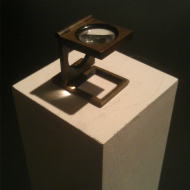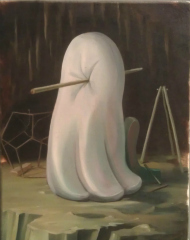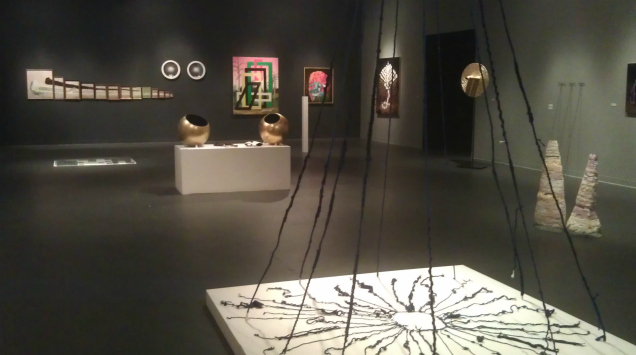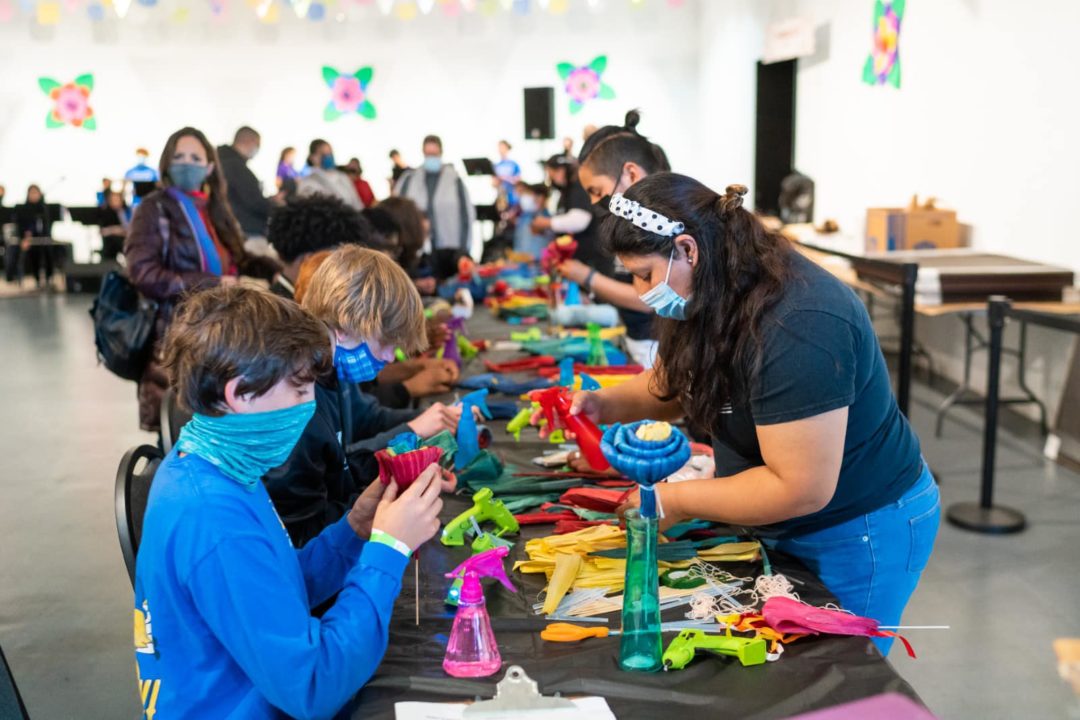Tomorrow (June 2) is the last day of MacKenzie Peck and Ryan Browning’s exhibition, Time Bandits. Last night artist/critic Mina Cheon joined the artists and Zeb Cook for a gallery talk, and today she sent us her insights in the form of the following critical essay. Read on! – Jed Dodds, Artistic Director
Time Bandits : Time Bandage
By Mina Cheon
Diving into the Techno-Sublime and Infinity
From here to there, somewhere to somewhere else, physical to virtual, technological to liminal experience, there is a fascination with the other and this othered space and experience; the experience of entering a VR system is now largely considered to be the classic cyberspace experience. As a hallmark of the ultimate full-body immersive experience, [we] seek answers as to why the body resists the mechanical but at the same time desires to escape into immersive technologies.
The “somewhere” else is highlighted as the unknown, indecipherable, mysterious, and ambiguous other space, and particularly with the reference to a “transition” from one realm to another, it is another example of shamanic-cyber metaphor. The escapism of immersive technology begins with the yearning to lose oneself, to be in suspended form in virtual space in perpetuity. The water metaphor [played up in cyberspace] is not simply a matter of nature or moistmedia, but it I also used for its vastness and in relation to infinity and transcendence.
(Cheon, Shamanism and Cyberspace, 2009, 155-156)
Joseph Beuys meets Ann Hamilton. Marcel Duchamp meets Mark Kostabi. That is what comes to mind while seeing the exhibition “Time Bandits” at the Creative Alliance in Baltimore, Maryland (May 5 – June 2, 2012) and in reference to the two artists in the two-person show: Mackenzie Peck and Ryan Browning.
The title of the show “Time Bandits” leads to a track about time, the major theme of the exhibition, and failure, the secondary and equally important theme. Time cannot be stolen, despite the time travel of Terri Gilliam’s 1981 film with the same title, which the artists are referencing. One cannot steal time – that is why time traveling is a fantasy and makes for a good sci-fi movie – but the idea of time warp says something about our notion of time itself. Why consider time as moving forward? Never turning back on time means it is always moving forward, but this is a western notion of time. Forwardness, frontier, movement, leaping, are all ideological constructs that suggest progress, but we fail in our postmodern world to see such progress (and yes, we are still in postmodern times, anyone who says otherwise is in denial, unless you want to call it post-apocalyptic times.)
The desire to steal time and capture it is closely related to the theme of desiring, conquering, and framing the impossible, like nature. Nature is terrifying in all its glories and catastrophes. Nature cannot be captured in time, which is why people have worn apparatuses to view nature, the landscape, and so many artists have tried to capture it, since it is impossible to capture. Sublime and magnificent nature have been replicated as art but to what avail? Why can’t nature be what it is, art what it is – ‘something else,’ similar to the possible ways that cyberspace can express ‘somewhere else’ and not just a mimic of reality or nature. While landscape painting disfigured the figure, abstracted space, lost subject matter, and in many ways catapulted conceptual art through its failure to capture nature itself, the desire to control, dominate, and capture nature has been a defining failure of the artist and a desire that seems to continue. This is where failure comes into picture.
Both artists, Mackenzie Peck and Ryan Browning, recognize the failure in capturing nature, memory, and the perfect picture. They are cyber culture children and artists, but are critics as well. They both deal with cyberspace, which has nothing to do with space but everything to do with time. Duchamp considered gray matter and the fourth dimension of time through the conceptual leap a viewer must take in order to experience his work, whether it was his rotoreliefs or étant donnés. The psycho- physio-sexual experience elongated time as viewers ventured into the escapism of his work. Peck creates objects as apparatuses to show how human perception is already skewed, and Browning creates paintings that are something else, possible in representation of cyberspace experience – nothing like nature, nothing like our desire for nature. Both artists express the failure of machines, apparatus, technology, and human desire that projects human sentience onto cyber systems that we operate with, but which also linger in between the humanly impossible and possible selves. Why mimic nature when it is fleeting and there is nothing to mimic? Why can’t cyberspace be what it is about – time – and art what it is about, something else?

All the works in the exhibition are generously hilarious, because they take us to the core of the problems of our time; they are funny because the work makes us laugh with nervousness that seeps into our bones. We want to capture it, the impossible, but we can’t. The motive to move forward, strike, attack, and conquer is an imperial move that dominates and empowers.Peck’s works display the impossibility of time, Browning’s the possibility of time, and neither has anything to do with a preemptive strike. You really have to see this show to understand what I’m talking about. My favorite two pieces are: Drawing a Line Through Time by Peck and Character Death by Browning. Of all the pieces, these two were the ones that simply stated their art worlds.

Drawing a Line Through Time has a long pedestal with an antique loop that shows a strand of hair changing color from black to white; Character Death is a gaming character that looks like a Pacman’s ghost that has been pierced by a needle. They are rather the smallest pieces in the show, but Drawing a Line reminded me of Nam June Paik’s Zen for Head, Zen for Film, reappearing as Zen for Loop. And as for Character Death, the gaming character seems to really be dying for once – no resurrections here. Both pieces also lend themselves to capturing the impossible, but it certainly was not found in nature but in art. They both reveal something about time suggesting it is possible to recreate realities that can be shaped without illusions and deceit; that an artist can pierce right through the thick of it all and tell it as it is.
I say Joseph Beuys meets Ann Hamilton and Marcel Duchamp meets Mark Kostabi, because Peck deals with rituals of memory and romanticization of cultures while showing other ways an apparatus or technology can serve our already disillusioned perceptions of reality; and Browning’s world Pop and all, futuristic and Kostabi-esque(but better), is placed in a highly contextual and conceptual ground that recalls Duchamp.
***
Time Bandits is about bandaging time. Time has been warped, sexualized, teased, and manipulated, as well as abused by media and such.There is an element of healing and hope in the works of Mackenzie Peck and Ryan Browning, here and today. Check it out at the Creative Alliance, Baltimore, Maryland.
Mina Cheon is a new media artist, scholar and educator who resides and works between Baltimore, New York, and Seoul, Korea. She has written reviews in NY Arts Magazine, Art US, Artist Organized Art, and Wolgan Misool Arts Monthly in Seoul, Korea.






